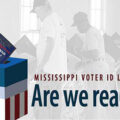ABOVE PHOTO: Keynote speaker, Hilary O. Shelton, Sr. VP for Advocacy at the National NAACP, gets the crowd going during the NAACP Voter ID rally in front of the Pennsylvania State Capitol in 2012 in Harrisburg, Pa.
(AP Photo/The Patriot-News, John C. Whitehead)
By Jeff Garis
Public Interest Law Center Of Philadelphia
The second day of proceedings in the Pennsylvania voter ID trial began with the petitioner’s first expert witness, Bernard Siskin, a statistician. Siskin was called on to match two databases: one from the Department of State listing registered voters (known as the SURE database), and one from PennDOT containing individuals with a valid PennDOT drivers license, non-driving ID, or Department of State ID.
Using a 12-step matching process to keep the numbers as conservatively accurate as possible, Siskin found that approximately 511,000 registered voters would lack appropriate identification to vote in the upcoming November 2013 election. After explaining his methodology and findings, Siskin noted the margin of error in his analysis proved to be statistically insignificant. Even gross estimates of false negatives and positives would keep the number at, as Siskin testified, hundreds of thousands of voters.
Michael Rubin of Arnold & Porter LLP led the direct examination of Siskin, during which he addressed criticisms from William Wecker, an expert witness called by the respondents. Siskin testified that even if Wecker’s methodology yielded more accurate results and the number of registered voters without proper identification was lessened by taking into account those voting absentee, incarcerated citizens, individuals residing in care centers or on military bases, and potential students, the number of disenfranchised registered voters would still be well over 300,000. Even if one assumes 70 percent of these individuals have a second form of acceptable ID, 100,000 voters would still lack the proper identification to vote.
After matching the databases, Siskin conducted a demographic analysis, examining the data of individuals without valid identification by race, political party affiliation, age, and gender. His analysis shows that specific demographic groups are much less likely to have appropriate identification. Groups with a statistically higher percentage of individuals without valid identification include African American, Hispanic, and Asian voters; registered Democrats; the youngest (18-22) and oldest (70-90+) voters; and women. These differences account for both individuals who are lacking in identification and those who hold expired identification.
He also analyzed geographic information and found that the average driving distance to a PennDOT Drivers License Center is 14.11 miles and 25 minutes round-trip. He found a significant percentage of the individuals without proper identification in the compared databases, 28.7 percent to be exact, must drive 30 minutes or more to the nearest center. In urban areas where the centers may be closer in mileage, driving is often unfeasible and individuals must take public transit for likely one to two hours in order to get to the nearest location.
In the afternoon, Siskin was cross-examined by the respondents’ counsel, who raised many hypothetical situations designed to challenge his calculations as well as his demographic analysis. These included raising questions about issues with hyphenated names; taking into account alternate identification such as IDs issued from community care centers, colleges and universities and military bases; potential out-of-state student fraud, and more.
In the redirect, Siskin demonstrated that these examples were out of the scope of his data or were accounted for through his use of reliability tests on pre-existing inherent limitations. According to Siskin these hypotheticals would not have significant effect on his findings. He stated for the record, “you can assume away the problem; you can assume away anything if you try hard enough,” arguing that hundreds of thousands of Pennsylvanians will be disenfranchised and unable to vote due to the restrictions imposed by Act 18.
The petitioner’s also continued to highlight the human face of this trial. On the witness stand today was Margaret Pennington, a 90-year-old resident of Avondale, PA. She has voted in nearly every election since she turned 21, when she proudly voted for FDR. Her husband died six years ago, and since then, her eyesight has deteriorated rapidly due to macular degeneration. She is now legally blind and unable to drive, read, or perform every day tasks on her own. Recently, she moved in with her eldest daughter, who owns a small business next to her house. This daughter takes care of all of Pennington’s affairs, including banking, driving, and more.
When Pennington learned of the voter ID law, she went to her local Drivers License Center with her daughter to get a non-driver PennDOT ID. She was told that they did not specialize in that type of ID and she would have to go to another center to get it, adding over an hour in each direction to their trip. This was unfeasible for her daughter, who would have to close her business or pay substitute staff for the day.
Despite having an expired license that has an accurate depiction of her appearance, Pennington no longer has a valid ID as outlined in the law. She can walk with help to her polling place only a block away, but will be unable to cast her vote this November if the law is not enjoined.
















Leave a Comment